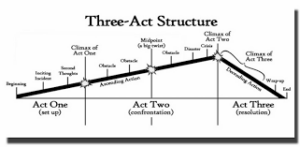
I have been reading a lot of scripts lately that have a lot of depth but not the kind of depth you want in a screenplay. They have depths of problems that are all interrelated. They have decent plots, but the stories lack structure. They have likable characters but haven’t given them clear goals. These problems are interrelated because you can’t have a strong story structure in your screenplay, or any structure at all for that matter if your protagonist doesn’t have a clear goal.
Screenplay structure marks the protagonist’s progress toward achieving her goal.
Story structure is not just some arbitrary guideline that some guy in a big studio office demanded. It is not a random rule for screenwriters to follow, only to give executives a reason to pass on a script if it doesn’t. The structure of a screenplay has a significant and important purpose in the telling of a story. It marks the protagonist’s progress toward achieving her goal.
Thank you for Story Structure’s Plot Points.
The first main plot point is the inciting incident that calls the hero to action. The next plot point is the transition from Act I to Act II when the hero Crosses the First Threshold, leaving behind the Ordinary World of her past life and committing to the Special World of the adventure where she will attempt to accomplish whatever goal she has been called to accomplish. The next plot point is the twist in the middle of Act II that divides Act II in half and forces the hero to recommit to the adventure in a way she hadn’t been previously prepared for. The next plot point transitions us from Act II to Act III and is often referred to as the “all is lost” moment. This is when the hero, usually because she hasn’t overcome some internal flaw or wound or has some inner need that hasn’t been addressed, loses everything and appears to have lost out on the chance to accomplish her goal. The final plot point is the climax, the final challenge for the here in which she finally does (or doesn’t) accomplish the goal she was called to accomplish at the beginning of the story.
These are not arbitrary requirements. These are integral components to the telling of an effective, dramatic story. Without these moments, you might have a plot, but you don’t have a story. I often tell screenwriters after reading their screenplays that the plot is what happens, but the story is why we care. If you have a plot that no one cares about, then you don’t have a story.
Your Protagonist Must Have a Clear Outer Goal.
This might come across as Screenwriting 101, but you would be surprised how many screenplays I’ve read recently in which the protagonist has no clear outer goal. What should also be mentioned is that there should be an inner need that conflicts with that outer goal. That is how you get character depth, and that is another great way to build drama.
The point is, however, that without that outer goal, it’s impossible to track the hero’s progress toward it. If the hero has no goal, there can be no story structure. The two of them go hand in hand. You have both, or you have neither.
So, if you feel like you’re banging your head on the wall because you can’t get the screenplay structure as tight as you want it, double-check your protagonist. Does she have a clear and well-defined goal, and has the story been built to demonstrate her progress toward achieving it? That is how the story should flow. It gives you good pacing, and it helps you build drama. Most importantly, when a story is structured properly, it allows the screenwriter to tap the maximum amount of creativity to create the best story possible.